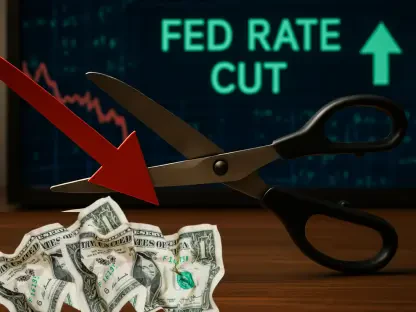On a seemingly routine trading day, September 23, the U.S. stock market experienced a sharp and unexpected downturn, with the Dow Jones Industrial Average, S&P 500, and Nasdaq Composite all closing in the red, abruptly ending a three-day run of record-high closes. This sudden shift left investors grappling with uncertainty, searching for explanations amid a flurry of economic signals and policy statements. The catalyst for this slide appears to lie in the words of Federal Reserve Chair Jerome Powell, whose recent remarks on interest rates and equity valuations reverberated through Wall Street with palpable impact. Beyond his comments, a mix of corporate earnings reports, geopolitical developments, and looming economic data releases added layers of complexity to an already jittery market. As the dust settled, the Dow closed at 46,912.30, down 0.84% or 398.70 points, while the S&P 500 shed roughly 0.6%, and the Nasdaq Composite fell nearly 1%. This moment serves as a stark reminder of how intertwined market sentiment is with central bank rhetoric, corporate performance, and broader economic indicators, setting the stage for a deeper exploration of the forces at play.
Federal Reserve Policy and Market Impact
Powell’s Cautionary Remarks
Federal Reserve Chair Jerome Powell’s recent speech at an event hosted by the Greater Providence Chamber of Commerce in Rhode Island marked a turning point for market sentiment on September 23. His cautious tone regarding future interest rate cuts, following a modest 25 basis point reduction the previous week that set the benchmark rate between 4% and 4.25%, signaled a deliberate approach to monetary policy. Powell emphasized the central bank’s struggle to balance its dual mandate of curbing inflation while supporting employment, describing the situation as one with “near-term risks to inflation tilted to the upside and risks to employment to the downside.” This candid acknowledgment of a challenging economic landscape without a clear, risk-free path forward unsettled investors who had grown accustomed to anticipating more aggressive easing measures. The weight of his words was felt immediately, as the market’s bullish momentum from earlier in the week began to falter under the shadow of uncertainty about the Fed’s next steps.
Adding to the unease, Powell’s observation that equity prices appeared “fairly highly valued” by many measures struck a particularly sensitive chord among market participants. This assessment was not merely a passing comment but a pointed reminder of potential overextension in stock valuations, especially after a string of record highs. Investors interpreted this as a subtle warning that the Fed might not rush to support markets through rapid rate cuts if inflationary pressures persist. The timing of this statement, just ahead of critical economic data releases, amplified its impact, prompting a swift reevaluation of risk across portfolios. As a result, the optimism that had fueled recent gains was replaced by a more cautious outlook, with traders bracing for potential headwinds that could challenge the sustainability of current market levels.
Market Reaction to Fed Rhetoric
The market’s response to Powell’s remarks was both immediate and pronounced, with major indices reflecting a sharp decline on September 23, signaling the significant impact of Federal Reserve commentary on investor sentiment. The Dow Jones Industrial Average, which had been riding a wave of optimism, closed down 0.84%, shedding 398.70 points to settle at 46,912.30. Similarly, the S&P 500 lost approximately 0.6% of its value, while the Nasdaq Composite, heavily weighted toward technology stocks, saw a nearly 1% drop. These losses snapped a three-day streak of record-high closes, underscoring the fragility of investor confidence when faced with sobering commentary from the Federal Reserve. The swift pivot from bullish to bearish sentiment highlighted just how reliant the market has become on central bank signals for direction, particularly in an environment where every policy nuance is scrutinized for clues about future economic conditions.
This heightened sensitivity to Fed rhetoric is further compounded by the anticipation of key inflation data, specifically the Personal Consumption Expenditures (PCE) index set for release later in the week. Investors are keenly aware that persistent or “sticky” inflation could derail hopes for additional rate cuts in the coming months, a concern that Powell’s cautious stance only intensified. The market’s reaction on this day was not just a response to a single speech but a reflection of broader anxieties about the Fed’s ability to navigate competing economic pressures. As trading volumes spiked and volatility returned, it became clear that Wall Street is hanging on every word from the central bank, parsing statements for hints of whether support through lower rates will materialize or if a tighter policy stance might prevail in response to inflationary risks.
Corporate Earnings and Sector Dynamics
Technology Sector Volatility
The technology sector, often viewed as the engine of market growth, exhibited significant volatility on September 23, contributing to the broader downturn in the Nasdaq Composite. Micron Technology stood out with a strong fiscal fourth-quarter earnings report, surpassing Wall Street expectations by posting revenue of $11.3 billion against a forecast of $11.15 billion and adjusted earnings per share of $3.03 compared to an anticipated $2.84. Driven by robust demand for AI-related products, this performance sparked a notable rise in Micron’s stock price during after-hours trading, offering a glimmer of optimism in an otherwise turbulent market. Analysts are now closely watching whether this success signals a sustained trend of AI-driven revenue for chipmakers, or if it remains an isolated bright spot amid broader sector challenges.
In contrast, Nvidia, a heavyweight in the AI and technology space, experienced a 2% pullback on the same day, following a 4% surge to a record close of $183.61 just a day prior. The earlier gain was fueled by news of a $100 billion investment in OpenAI, described by Nvidia’s CEO Jensen Huang as a landmark project for AI infrastructure. However, the subsequent decline reflected investor skepticism about the financial implications and accounting treatment of such a massive commitment. This dichotomy within the tech sector—where strong earnings from some firms are offset by uncertainty surrounding others—illustrates the fragile balance of optimism and caution. As technology stocks remain a critical driver of market performance, their mixed signals on this day added another layer of complexity to the overall narrative of decline sparked by external policy concerns.
Mixed Performance Among Tech Giants
Among the influential group of tech giants often referred to as the “Magnificent Seven,” performance on September 23 was notably uneven, further highlighting the sector’s volatility and the unpredictable nature of the market. Nvidia and Amazon both saw declines of around 2%, tempering the enthusiasm that had propelled recent gains in the tech-heavy Nasdaq. These pullbacks came as a stark contrast to the previous day’s momentum, when Nvidia’s OpenAI deal and strong iPhone demand had boosted Apple by over 4%. Meanwhile, Meta managed a slight uptick of 0.3%, offering a small counterbalance to the broader downward trend. This patchwork of results underscores the market’s heavy reliance on technology as a growth driver, while also revealing underlying concerns about whether the current rally can be sustained amid external pressures like Fed policy uncertainty.
The uneven performance of these key players reflects a deeper tension within the market, where investor sentiment is split between confidence in innovation and apprehension about overvaluation. Tech stocks, often seen as bellwethers for broader economic health due to their significant weighting in major indices, are under intense scrutiny following Powell’s remarks on high equity valuations. The declines in Nvidia and Amazon suggest that even blockbuster deals and strong fundamentals may not shield companies from broader market anxieties. As these giants navigate a landscape of high expectations and potential policy headwinds, their mixed outcomes on this day served as a microcosm of the larger uncertainty gripping Wall Street, where every earnings report and strategic move is weighed against an unpredictable economic backdrop.
Geopolitical and Policy Influences
Government Involvement in Corporate Deals
Geopolitical developments and government policy decisions played a substantial role in shaping market dynamics on September 23, with specific stocks experiencing sharp movements due to the Trump administration’s active involvement. Lithium Americas saw its stock surge by up to 90% in post-market trading following reports that the administration is seeking a 10% equity stake in the company as part of renegotiations for a $2.26 billion Energy Department loan for the Thacker Pass lithium project in Nevada. This move, mirroring similar equity agreements with firms like Intel and MP Materials, reflects a strategic push to secure domestic supply chains for critical minerals and technology. Such direct government intervention introduced significant volatility, creating both opportunities and risks for investors focused on sectors tied to national priorities.
In another notable development, negotiations for a potential order of 500 Boeing aircraft by China have reached their final stages, described as a “huge order” by U.S. Ambassador David Perdue. This prospective deal, which could serve as a centerpiece of a U.S.-China trade agreement, lifted Boeing shares by over 2% in premarket trading, offering a rare boost amid a sales drought since 2017. The prospect of easing tensions between the two nations through this agreement injected a dose of optimism into the aerospace sector, countering some of the broader market pessimism. However, the reliance on geopolitical negotiations for such market movements underscores the unpredictable nature of political influence, where outcomes remain contingent on diplomatic progress and can shift rapidly with changing priorities or unforeseen disputes.
Policy Impacts on Business Operations
Beyond direct corporate deals, broader policy changes and political rhetoric from the Trump administration introduced additional layers of uncertainty for businesses on September 23. A striking example is the new $100,000 fee on H-1B visas for foreign workers, a policy that drew surprise from industry leaders like JPMorgan Chase CEO Jamie Dimon. This significant cost increase has the potential to disrupt corporate hiring strategies, particularly for tech firms reliant on global talent, adding another hurdle in an already challenging economic environment. The ripple effects of such regulatory shifts are likely to influence operational costs and long-term planning, further complicating market sentiment as companies reassess their growth strategies under new constraints.
Meanwhile, political statements have also had a direct impact on specific stocks, as seen with Kenvue, which rebounded by 4.8% after a 7% drop triggered by President Trump’s unsubstantiated claim linking Tylenol use during pregnancy to autism. This incident highlights how offhand remarks from high-profile figures can sway consumer goods stocks, often regardless of factual basis, creating sudden volatility for companies in the public eye. These policy and rhetorical influences demonstrate the growing intersection of politics and markets, where government actions—whether through legislation or public statements—can alter investor perceptions overnight. As businesses navigate this unpredictable terrain, the market remains vulnerable to swings driven by factors far removed from traditional financial metrics, amplifying the sense of unease already fueled by economic and monetary policy concerns.
Economic Indicators and Market Sentiment
Mixed Signals from Economic Data
The broader economic landscape on September 23 presented a complex and somewhat contradictory picture, with key indicators pointing to a cooling yet still expanding U.S. economy. S&P Global’s US Flash PMI data for September revealed manufacturing growth at 52, slightly below the forecast of 52.2, and services growth at 53.9, under the expected 54. While both figures remain above the 50 threshold indicating expansion, they suggest a slowdown from recent peaks, raising questions about the durability of economic momentum. Additionally, the data highlighted reduced hiring activity and persistent input price inflation, particularly in manufacturing, which could squeeze business margins if higher costs cannot be passed on to consumers. This mixed economic report fueled concerns among investors about whether the current growth trajectory can withstand mounting pressures, especially in light of the Fed’s cautious stance on further stimulus.
Compounding these concerns is the labor market’s apparent softening, as evidenced by the PMI data’s indication of reduced hiring. A cooling job market, alongside ongoing inflationary pressures, paints a picture of an economy at a crossroads, where the balance between growth and stability remains precarious. For investors, this data serves as a reminder that the record highs achieved earlier in the week may not be sustainable without clearer signs of robust economic health. The combination of slower-than-expected sector growth and persistent cost pressures suggests potential headwinds for corporate profitability, adding to the wariness sparked by Powell’s remarks. As the market digests these signals, the focus shifts to upcoming data releases that could either confirm a slowdown or offer reassurance of continued resilience.
Alternative Metrics and Recession Fears
In addition to traditional economic indicators, alternative metrics on September 23 captured attention as investors sought broader clues about the economy’s direction amid heightened uncertainty. Gold futures reached a record high, surpassing $3,800 per troy ounce, driven by expectations of further Federal Reserve easing and lingering inflation concerns. Analysts from major institutions like Goldman Sachs and UBS predict continued upside, with forecasts targeting $4,000 and $3,900 by mid-2026, respectively. This surge in gold prices reflects a classic flight to safety, as investors hedge against economic volatility and inflationary risks. The precious metal’s performance stands as a barometer of market unease, suggesting that despite recent stock market gains, a significant portion of capital is seeking refuge in assets perceived as more stable during turbulent times.
Beyond gold, unconventional indicators also contributed to the narrative of economic vigilance, reflecting a broader caution among market participants. Metrics such as men’s underwear sales and cardboard box demand, though not definitive predictors, have historically been cited as offbeat signals of consumer confidence and industrial activity, often sparking curiosity in financial circles. While these measures lack the rigor of official data, their mention in financial discussions underscores a pervasive sense of caution among market participants wary of a potential downturn. The National Bureau of Economic Research remains the authority on defining recessionary periods, relying on comprehensive data rather than anecdotal metrics. Nevertheless, the attention to these alternative signals highlights an environment where every piece of information, no matter how unconventional, is scrutinized for insight into whether the economy is on the brink of a shift, amplifying the tension already present due to mixed traditional indicators and policy uncertainty.
Navigating Future Uncertainties
Anticipating Key Data Releases
Looking back at the market slide on September 23, the influence of Federal Reserve Chair Jerome Powell’s cautious remarks was undeniable, as they reshaped investor sentiment and triggered declines across the Dow, S&P 500, and Nasdaq. The immediate aftermath saw a market grappling with the reality of potential overvaluation and the Fed’s hesitance to commit to further rate cuts. As the week unfolded, the focus inevitably turned to the Personal Consumption Expenditures (PCE) index release on Friday, a critical piece of inflation data that held the power to either ease or exacerbate the tensions Powell’s comments ignited. Investors and analysts alike recognized that a reading indicating persistent “sticky” inflation could further dampen hopes for monetary easing, while a softer figure might restore some confidence in the Fed’s ability to support growth without stoking price pressures.
Strategic Moves for Market Stability
Reflecting on that pivotal day, it became clear that navigating the current economic landscape required a strategic approach from both investors and policymakers, especially in light of varying corporate performances and external influences. Corporate performance, particularly in the technology sector, needed close monitoring, as the mixed results from giants like Nvidia and Micron suggested that reliance on AI-driven growth carried both promise and risk. Meanwhile, the significant role of geopolitical and policy developments, evident in stock movements for companies like Lithium Americas and Boeing, highlighted the importance of staying attuned to government actions that could reshape specific industries. For the future, market participants were advised to diversify risk exposure and prioritize data-driven decision-making, especially as economic indicators continued to send mixed signals. By focusing on adaptability and vigilance, stakeholders could better position themselves to weather the uncertainties that lay ahead, ensuring resilience in a market still reverberating from the events of September 23.









